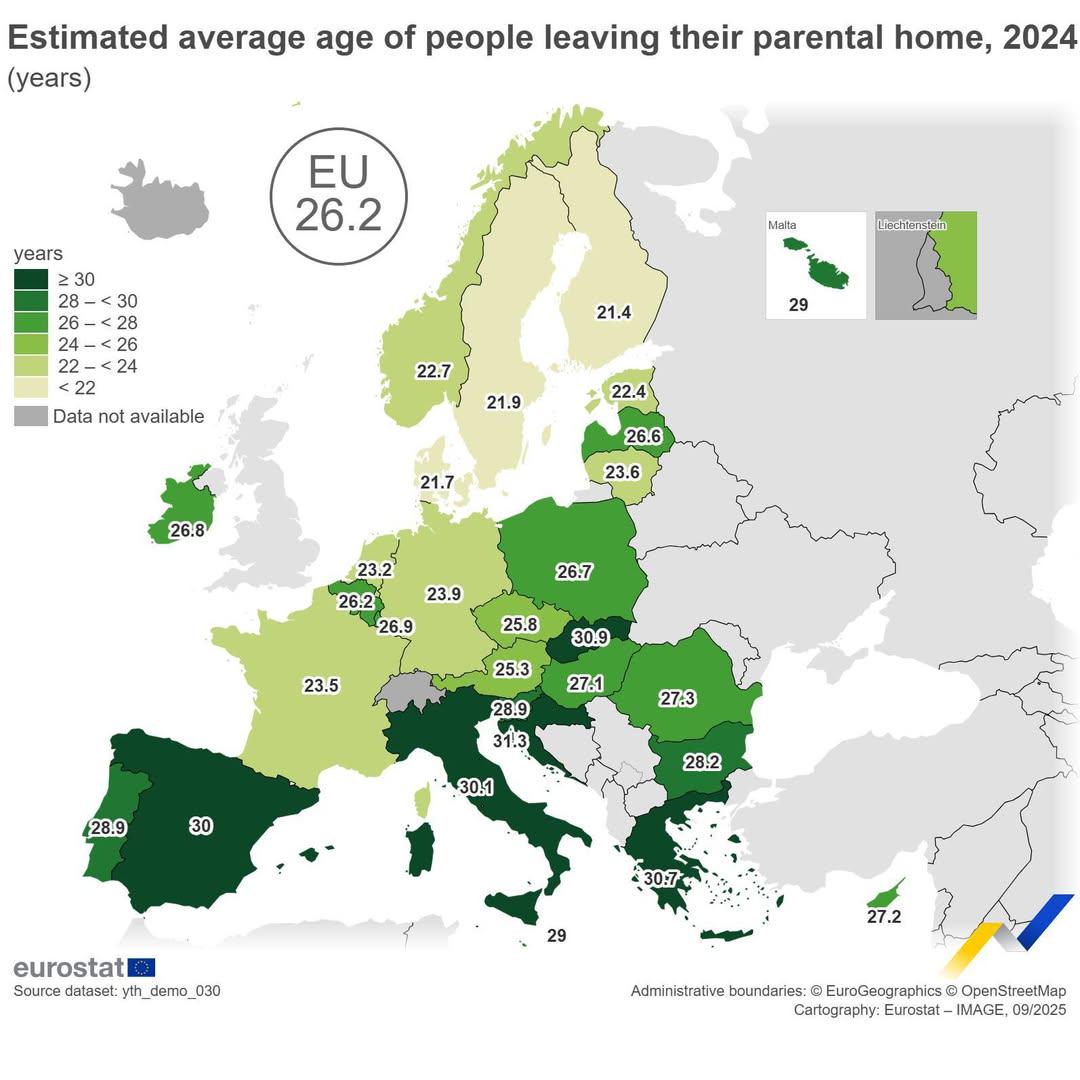EU Young People Leaving Home Age Map


Marcus Rodriguez
Historical Geography Expert
Marcus Rodriguez specializes in historical cartography and geographic data analysis. With a background in both history and geography, he brings unique...
Geographic Analysis
What This Map Shows
The map titled "When do young people in the EU leave home? (2024)" provides a clear visual representation of the age at which young adults in various European Union countries typically move out of their parental homes. This phenomenon, often referred to as "leaving home," reflects broader societal trends, economic conditions, and cultural norms across Europe. By examining the age of departure, we can gain insights into the different lifestyles, financial situations, and cultural attitudes towards independence found in diverse EU member states.
Deep Dive into Young Adults Leaving Home
The decision to leave home is a significant milestone in a young person's life, shaped by various factors such as socio-economic conditions, education systems, and cultural traditions. Interestingly, the average age at which young people leave home in the EU varies widely, with some countries showing a trend of independence at a much earlier age compared to others.
In general, Nordic countries like Sweden and Denmark lead the charge, where the average age for young adults to leave home hovers around 19 to 20 years. This trend can be attributed to a strong emphasis on individualism and the availability of social support systems, such as affordable housing and educational grants. The progressive policies in these nations encourage early independence, allowing young adults to pursue their education or work opportunities with greater ease.
Conversely, southern European countries such as Italy and Spain show a much later average age for leaving home, often around 30 years or even older. This can be linked to cultural factors where familial ties are incredibly strong, and young adults often reside with their parents until they marry or secure stable employment. Economic factors also play a role; with rising housing costs and high unemployment rates in these regions, many young adults find it financially challenging to move out.
In countries like Germany and France, the average age falls somewhere in between, typically around 23 to 26 years. Here, the shift towards independence is influenced by the availability of vocational training programs and a robust job market that enables young adults to find work sooner. Interestingly, urban areas in these countries may see a younger demographic leaving home compared to rural regions, where lifestyle and economic opportunities differ significantly.
Regional Analysis
The map reveals a fascinating regional divide in the EU regarding when young people leave home. For instance, in the Baltic states, we see an earlier trend similar to the Nordic countries, suggesting that these nations might be influenced by similar socio-economic factors that promote independence. Estonia, Latvia, and Lithuania show averages of around 20-21 years, indicating a shift towards independence that aligns with their socio-economic development.
In contrast, Eastern European countries like Poland and Hungary depict a later age of departure, typically around 27-29 years. This trend mirrors the southern European pattern, where cultural norms and the lingering effects of economic transition post-communism influence young people's living arrangements. Have you noticed that countries with stronger social welfare systems often have younger populations leaving home? This correlation highlights the impact of government policies on individual life choices.
Interestingly, the map also highlights the impact of urbanization. In metropolitan areas, young people tend to leave home earlier due to better job opportunities and a more vibrant social scene. For example, cities like Berlin and Paris attract young adults, prompting them to establish independence sooner than their counterparts in rural areas.
Significance and Impact
Understanding when young people leave home is not merely an academic exercise; it carries significant implications for policymakers, urban planners, and social services. As we see shifts in these trends, it becomes crucial to address the challenges young adults face in moving out—such as housing affordability, job security, and access to education.
Current trends indicate that as economies recover post-pandemic, there may be an uptick in the average age at which young people leave home, especially in areas where housing costs continue to rise. This could lead to longer-term societal implications, such as delayed family formation and changing demographics. Furthermore, as we look towards the future, understanding these dynamics can help shape policies that support young adults in their transition to independence, ensuring that they have the resources and opportunities necessary to thrive.
In summary, the age at which young people leave home in the EU is a complex interplay of cultural, economic, and social factors. The map serves as a valuable tool for visualizing these differences and understanding the broader implications of young adulthood in today's society.
Visualization Details
- Published
- September 23, 2025
- Views
- 80
Comments
Loading comments...